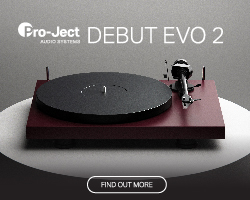PERREAUX 200iX INTEGRATED AMPLIFIER REVIEW
Perreaux’ 200iX integrated amplifier is made in New Zealand and costs £5850 in the UK. It’s a fully-fledged integrated with moving magnet and moving coil phonostage, onboard DAC, Bluetooth, and headphone amplifier. It comes in a wide range of funky colour options and an interesting remote app for iOS and Android. Stuart Smith has a play.
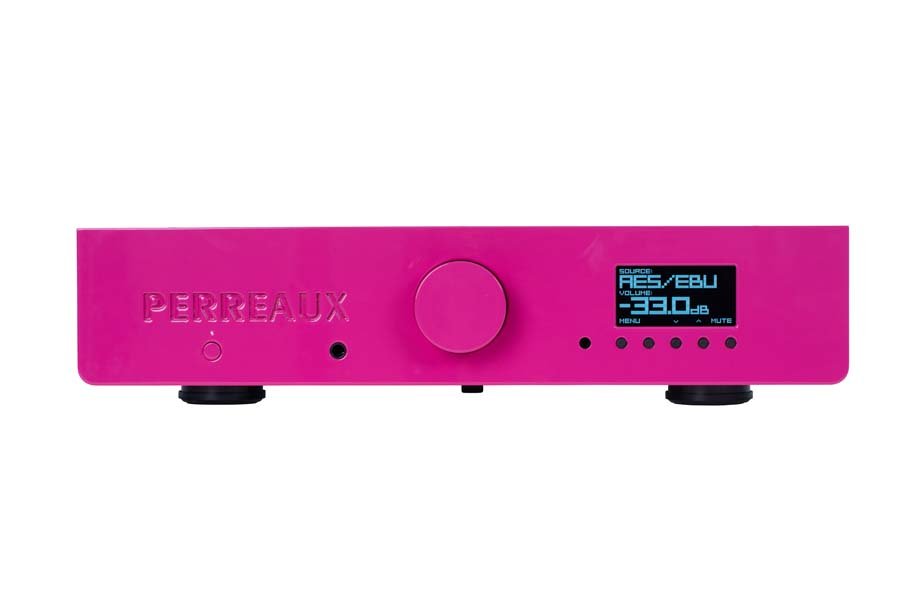
A striking design that some will love and others will not like so much. I think it’s fab!
Boring HiFi is boring! Well, that’s not strictly true as there’s some absolutely fantastic sounding kit that comes in less than interesting boxes. Pretty much, there’s a whole lot of similar (ish) looking black and silver boxes out there with little to differentiate them from each other on the rack or on the shop of your local HiFi retailer. Step up to the podium New Zealand based brand Perreaux and their 200ix integrated amp. If you want it in black, you can. If you want it in white, you can. If you want it in pink, grey, yellow, blue, light blue or orange, you can. In fact, you can have it in “any colour your heart desires” claims the company’s website, and I’ve seen a rather splendid looking rainbow coloured 200ix. Now there’s going to be a number of folk out there in audiophileland who eschew the idea of having anything with a bit of colour on their HiFi rack, but personally, I reckon this is a bold and interesting move on the part of Perreaux – anyway, if you want a black one you can have it in black, though it is a glossy black. Needless to say, the review sample arrived in PINK. Bright pink. What else could it be given one of the slogans we use for our banners at shows and other events is “The Future’s Pink!”. So is this integrated from the other side of the world the future? Let’s find out.
BUILD AND FEATURES
Apart from the heatsinks to the sides of the amp, the back-panel and the OLED display, and the quarter-inch headphone jack everything on the 200ix is pink. It’s a bold statement and at first, I did think this was a splash of colour too far, but it grew on me and I actually think it’s a pretty cool thing. Perreaux could have compromised and done the volume knob and the on/off switch in black, but in the end, it’s better as it is – in my opinion. As mentioned, some folk will not like this!
I’ve had this amp a fair old while and have used it on and off throughout that time by way of getting to know it and get it run in before listening properly. However, I was a bit miffed that I couldn’t get the Android app to work as I absolutely loved the idea. Looking back I just should have contacted Perreaux as when I did they did do something to the Android app and it worked flawlessly. The 200ix comes with a remote but highly innovative the Android or iOS app is brilliant and since it began working (a redownload of the updated app) I’ve not touched the traditional remote – the remote supplied was pretty big and workaday but it looks like a more compact unit is now shipped with the 200iX. Regular readers of my reviews will know that crappy remotes are a bit of a bugbear of mine and the Perreaux app simply does away with it (for the main part) and brings it onto your phone. It looks cool, is a piece of cake to use and does almost everything you could want. Open the app up, it finds your 200iX and connects automatically. No more searching around down the back of your sofa for your remote as it’s right there on the device you are controlling your streaming from – of course, it also works with other inputs and lets you switch between them and turn the volume up and down and the amp on and off. You can also hit the menu button and open the menu up on the screen of the OLED but the screen on the amp is pretty small and you can’t see what you are doing unless you are very close to the amp – I’s like to have the app be able to scroll through the menu and bring it up on your device. Anyway, it’s not absolutely perfect but it is very good and a nice innovative touch that I really enjoyed using.

The app for Android and iOS is a real winner for me and Perreaux should be congratulated on getting this so right.
So, on the front of the amp itself, you have the on/off button, a headphone jack (proper quarter-inch size), a volume knob, an OLED screen and 5 small push buttons that are there to navigate the menu. There’s also a small window for the traditional remote’s receiver.
Around the back the first thing you notice is that it is set out a little differently from most amps – the left and right inputs are to the left and right of the amp rather than being together which I didn’t really like very much but YMMV– look at the picture below.
You’ve got five RCA inputs that include a phono input (MM or MC), a line out, a pre-out and an amp in. There’s a single balanced XLR input and the usual speaker binding posts. On the digital side, you have a couple of optical inputs, a USB input, two coaxial inputs and an AES/EBU XLR input. There’s also a small aerial for Bluetooth, a trigger out, IR in and outs and an RS 232 socket. The back panel is busy but not too fiddly to get things I and out. However, I was playing with a cheaper turntable we had in for review (sent back without review as it wasn’t speed stable) and I found I had to split the cables apart to get them to fit left and right – not a major hassle but worth mentioning.
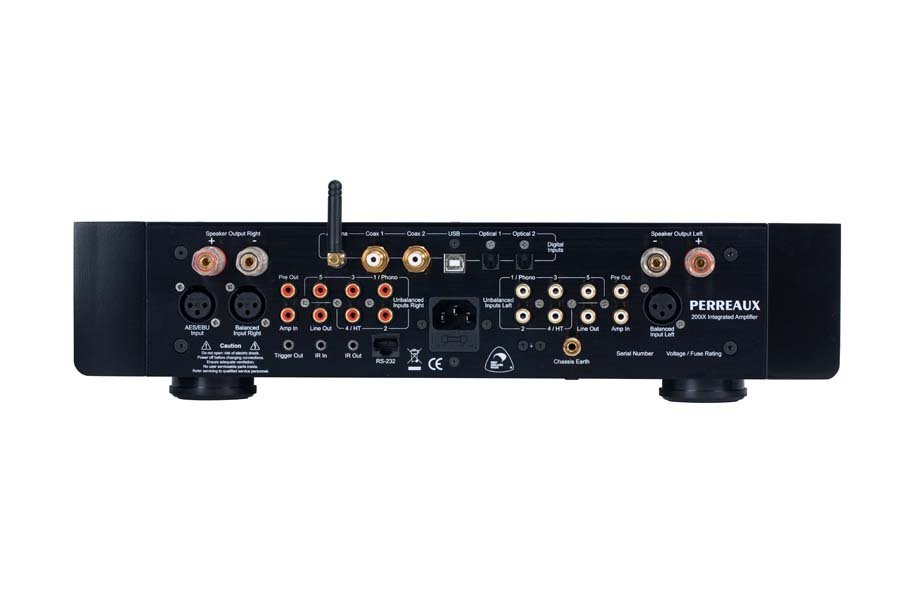
Lots of connections and a left/right layout for inputs.
The onboard SABRE ES9038PRO DAC will handle everything up to 24/192kHZ on optical/coax and with USB everything up to 32/384kHZ and DSD up to 256. That should keep most people happy for the foreseeable future!
The output of the amp is 200W into 8 and 300W into 4 ohms, again, more than enough oomph to satisfy most people and to drive most speakers.
For those that use it, there is the option to stream via Bluetooth from your tablet or phone.
Finally, there’s the Class A headphone amp that Perreaux say will power headphones 8-600 ohms.
All in all the 200ix is a very well-featured, nicely put-together integrated amplifier that looks funky as you like. The inclusion of the Android/iOS is a stroke of genius in my opinion and my only quibble with it is that I’d have liked to have been able to prat about with the menu and see what I was doing on the phone screen rather than having to get close to the amp.
The price is £5850 in the UK and to be honest, that seems to be a petty reasonable asking price for an amp with so many features onboard. Remember, you aren’t going to have to fork out for a DAC or phonostage when buying this amp and the Bluetooth connection is a bit of a bonus feature.
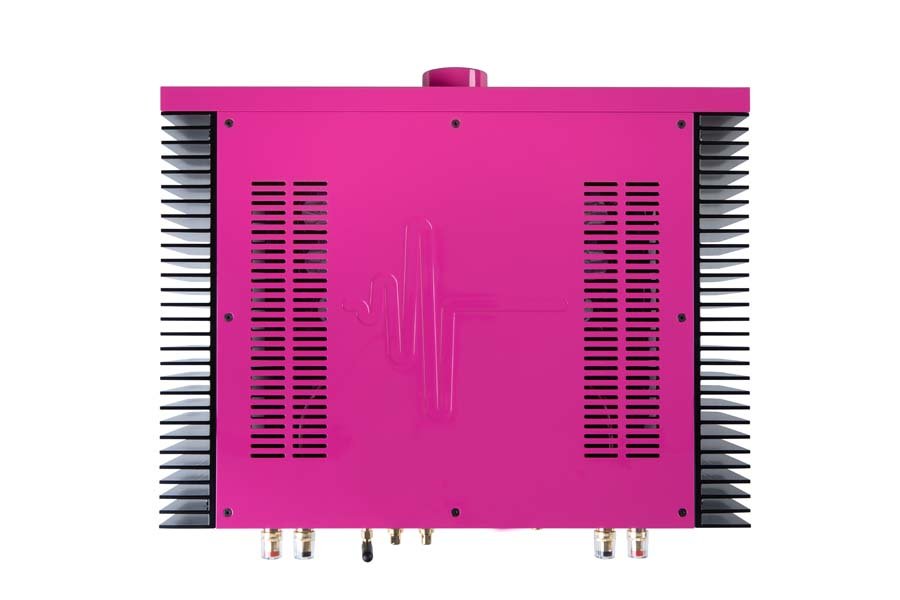
Well ventilated and with black heat sinks.
SOUND QUALITY
I was going to set this amp up in the smaller system where we aim for around three grand a box (ish) but my thoughts were that this is the best part of six grand in the UK and so why not at least give it a go in the bigger system and let it power the Audiovector R6 speakers. And so that’s just what I did. I was also going to attach the amp to either the Auralic Streamer or the Stack Audio streamer that we have in our main systems, but I wanted to go with the all-in-one vibe and so used a Raspberry Pi running Ropiee and using a linear PSU. Adding a turntable to this makes for a very simple and elegant three (four with PSU) box system that covers all bases and is pretty compact. I digress.
First off it’s pretty immediately obvious that we are listening to an amplifier that is outclassed by the AVID amp that we recently had in for review, but then that’s really no surprise whatsoever given the differences in price. Secondly, it’s apparent that this too is a very good amplifier at its price. Actually, I really liked it a lot and spent a good few days just sitting listening to music and avoiding the television news that seemed to have gone from bad to catastrophic overnight.
Whilst the Perreaux doesn’t have the scale with regards to soundstaging that the AVID amp had there’s still a good feeling for the recording being laid out in front of you. I’d also say that in this respect it wasn’t in the same league as our Krell KST100 but that is again a bit unfair given what you’d have to pay to have an amp of the Krell’s class bought new today. In direct comparison to these two amps, the Perreaux sounds a little more small-scale in its presentation of the soundstage, but is definitely on a par with our Merrill Thor amplifiers. What the Perreaux does very well is maintain the stability of the soundstage and even at low volumes it’s very easy to pick out the individual parts of a mix. Listening to The Strokes’ first album, which can sound messy and thrown together, it’s clearly evident that this isn’t a record that has been produced by Chimp and Co and is actually a pretty sophisticated production, though with an intentionally (contrived?) lo-fi feel to it. What was particularly pleasing listening to this record (for about the fifteenth time since this amp went in the system) was that nothing is lost at low volume with the Perreaux. Bass guitar is particularly easy to follow, and the somewhat mixed-back drums really underpin the whole track. This is a good amplifier!

Inside the 200iX shows a big transformer and cap’ bank. Everything looks well laid out and neat and you can see why the back panel is laid out as it is.
Turning up the volume and popping on Jack de Marseille’s Psyche Le Funk from the Free My Music album, it’s clear that this amp is a dynamic player, and whilst it could be very easy for an amp to get lost in this dirty-funk-techno track the Perreaux takes it in its stride. The analogue-sounding bass line that nags throughout is rock solid and the relentless breakbeat drum track just feels right – nothing too forward in the mix and nothing taking charge where it ought not to. The squelchy synth line fills the room and again nothing seems to get lost in the mix with the Perreaux. There’s a speed and a reactiveness with the amp that suits this kind of music. It would be easy for the bassline on the following track, Bump, to become a bit of a problem (it’s low and brooding) but this amp is in control and the bassline sits there correctly. The breakdown on this latter track is a bit busy, but the Perreaux keeps its cool until that bassline comes back. What I’m trying to say here is that when the volume is pushed and the music takes a distinct party feel, the 200ix delivers. Now, to say this is a party amp would be a bit unfair because that suggests it’s all boom and tizz, but it isn’t and there’s detail and finesse as well as power on show here too. All that said, it’s a great amp for this kind of music and even when the track Feelin’ it comes in with a very dub bassline the amp is composed and fully in charge. Yes, it’s a little smaller sounding in scale than the Krell amp but it still manages to separate the music into its component parts and yet present them as a satisfying whole. Effects pulse out into the room, decay nicely into silence in their bit of the mix whilst others come and go into theirs. The Perreaux is excellent with techno, dub and electro!
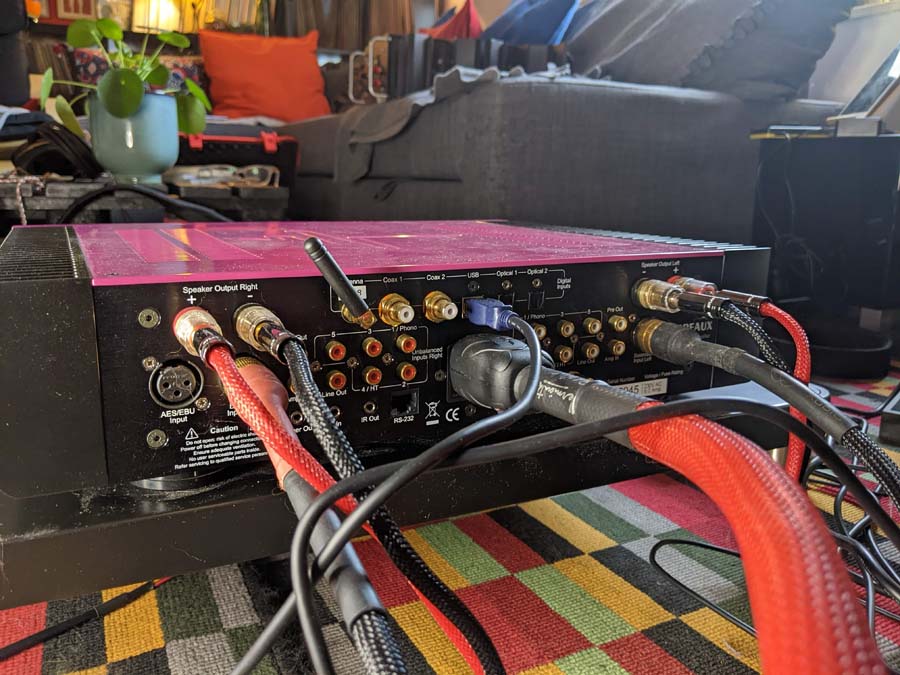
The back of the amplifier in use.
Apparently, at some point in the review of HiFi equipment, it is the law that I have to reach for Roon and stream me some female vocal music. If I don’t do this the HiFi review police apparently kick your door down and install Celine Dion in your listening room for a couple of weeks – and that really is the last thing I want. I compromise and reach for Elaine Elias and her Made In Brasil album. Her voice on Este Seu Olhar/Promessas reaches out into the room and the Perreaux never allows it to break up but conveys all its understated richness in full. Her Portuguese vocal inflexions are easy to hear, and whilst it is very much forward in the mix her vocal delivery sits above but never overtakes the backing Latin rhythms and orchestration. Shimmers on the cymbals on Driving Ambition are particularly pleasing in the way they hang in the air before fading. This, to me, shows that the amp is not only capable of doing solid bass and dynamics, as well as mid-range detail, but that it’s also able to get across good detail in the upper frequencies and communicate small details and musical cues that are so important in getting a fully rounded feel for a piece of music. This is not taxing music with regards to finding out what an amp can do, but the 200ix offers up a very pleasing and mellifluous sound. And, more importantly, I’ve once again put off the installation of that Canadian songstress in our main room.
So, the 200ix has a very capable onboard DAC that marries very well with a detailed and dynamic amplifier that delivers well across the sonic spectrum. Maybe my one gripe is that the 200ix isn’t as three-dimensional in its presentation as some other amps I’ve heard. That said, I sat and listened to a good deal of music in styles that I’d not really normally sit and listen to. Result.
PHONOSTAGE
The onboard MM/MC phonostage can be selected on the app’ remote but the screen on the amp is too small to change menu settings from afar and I’d like to see the menu options pop up on the app so this option is more usable. To access the menu on the amp you use the buttons to the right of the front panel, however, you can also use the volume knob to scroll (turn it) and select the options (press) which is really easy and really useful. There are two options on the phono stage and that’s just Moving Magnet or Moving Coil – I’ll be trying both. I would have liked to have seen more options for fine-tuning, particularly the moving coil’s parameters, but it is what it is.
Using our resident GoldNote Tuscany Red MC it’s pretty clear this is a very decent phonostage and it is both very quiet and dynamic on the MC setting. The separation between the channels is excellent and the characteristics of the amplifier are allowed to shine out rather than be overly affected by the attributes of the stage. Listening to Pablo Mateo EX Calathea EP ( Certain Music) the otherworldly techno feel is well delivered and the individual sounds in the mix are well lineated and layered in space. All in all, everything is present and correct and apart from the lack of fiddle-factor with regards to setting parameters – I’m a very happy techno bunny. I’d certainly not suggest that the €5K cartridge was out of place being partnered with the amp at all – in fact, as I often parrot, spend all you can on your transducers!
Switching over to MM (again only one setting) and the Sumiko Olympia cartridge (around €250 and much more likely to be the kind of cartridge partnered with this amplifier) it’s much of the same. The slightly laid-back feel of the Sumiko is evident and it’s well clear that the GoldNote is the better cartridge. However, the phonostage is still exceptionally quiet and well layered with regards to the soundstaging. In comparison to the melto phono from LAB12 we use I’d say that overall the phonostage in this amp is clearly the inferior of the two, but then you’d fully expect that given the price of the LAB12. I didn’t get the phonostage out to do a direct comparison but I’d say the onboard phono is more in line with the entry-level Graham Slee stages we have, with the advantage that you get MM and MC in one box here without needing to spend on a step-up up for MC.
All in all the phonostage is well appreciated and in truth and at this level, I have zero complaints at all other than the lack of being able to fine-tune the parameters, particularly for the MC side of things.

The 200iX is a striking statement in pink but is available in a whole host of colours, including black for the traditionalists. Now where did I leave my specs.
BLUETOOTH
I don’t use Bluetooth much at all and the truth is I find it a vastly inferior form of streaming, even using the supposedly CD quality standards – sorry and YMMV. However, I do fully understand that Bluetooth is massively convenient and hugely popular.
Pairing is easy. Open Bluetooth settings and there’s the 200ix Audio option. Press pair. Done.
You get the choice to turn on HD Audio (Qualcomm aptXHD) or to leave it turned off.
Streaming from YouTube and Neil Young’s Harvest Moon (Official Video) I’m actually pleasantly surprised by the audio quality. However, you cannot use the remote app (connected by Bluetooth) and Bluetooth audio at the same time, though you can fall back to using the supplied remote control unit for this.
As I say, I’m not a massive user of Bluetooth but it works well here with the only caveat being that you can’t use the control app at the same time.
HEADPHONE AMP
Invariably I leave the headphone amp until last when reviewing any bit of kit that includes one as it’s not my preferred way to listen to music, though, once again, I do appreciate that headphones are massively popular with many. I suppose my main gripe with headphone amplifiers on some integrated amps etc is that they are an afterthought and aimed at folk like myself for who headphone use is a pretty occasional affair. That doesn’t seem to be the case with the 200ix and the headphone amp performs really well powering the Sendy Peacock cans we use.
This is actually a very good headphone experience for an integrated amplifier and listening to United Future Organisation’s I Bet You Thought I’d Never Find You proves this to be a well-capable headphone amplifier and well up there with some of the standalone offerings I’ve been sent in the past to try out.
Again, like the amplifier itself, the experience is one of sounds being well-layered and separated in the mix – I know I bang on about this but it’s important. The headphone amp is dead quiet in itself and when the volume is turned up the amp just delivers more of the same and goes well over what would be sensible or comfortable. I was a little taken aback at the quality on offer here and so headed over to the Perreaux website to find out more about the headphone amp, and here lies the reason it sounds so good – the headphone amp on the 200iX is Perreaux’ SXH2 Class A amp. Detail and effortlessness are the order of the day with this H/A and I’d say it’s much less an add-on thrown in to enable the manufacturer to bung another feature onto the Spec’ list to justify the pricepoint and much more a well-thought-out addition for folk that use headphones a fair old bit.
QUIBBLES
Unable to use Bluetooth and the app at the same time on the same device. I have been informed that the OS version of the application does allow for use of both.
Lack of in-depth settings for, particularly, the Moving Coil input on the phonostage. Of course, a separate phonostage is available.
The screen is small and difficult to see and navigate from the listening position – I’d like to have full menu-diving ability built into the app. I am informed that this is something Perreaux are looking at and the app will undergo improvements and changes in the coming months and years.
Left and right layout of inputs on the back panel. Perreaux told me “This is a bit of a historic choice to keep left and right as much separated as we can, and at the same time keep the mains away from the channels. If you do it the traditional way, there is always a cross somewhere, either with L/R or with the channels and mains, and different lengths of tracks inside the amp. The downside is that the input cables sometimes need to be split.”
CONCLUSION
The Perreaux 200ix is a strong performer at the asking price and offers an excellent set of onboard features. The DAC is excellent and well-specified with regard to the files it will decode. The phonostage is also sonically excellent, though I do have issues with the lack of adjustability of parameters for Moving Coil cartridges in particular.
The iOS and Android control app is a fab addition that I think many will appreciate, though you cannot use it with the same device when streaming Bluetooth.
Sonically the 200iX has power and detail that is free of any nasties worth mentioning and I sat and enjoyed it way beyond the time I’d set aside for the reviewing process. The amp is especially good at layering within the soundstage and this may well separate it from other amps at this kind of price. It’s very easy to get on with and not at all fatiguing when listening for long periods.
The headphone amp is much less an afterthought and is a good performer that will satisfy even the more committed headphone user.
I have absolutely no hesitation in awarding this amp our Five Hearts award and feel it is only really let down at this pricepoint by a few niggles I have with it and which are outlined above.
AT A GLANCE
Build Quality and Features:
Funky colours available including black for the less adventurous among us
Well put together and built
Excellent feature set
The headphone amp is a proper amp and not a thoughtless add on
Good quality phonostage but lacks the ability to alter parameters, particularly for MC users
The app is excellent and free
Included remote is functional but out of keeping with the amp itself
Sound Quality:
Excellent whatever the input
Well layered and separated soundstage for the level of amp
A dynamic and powerful sound that’s certainly not out of place powering our €26K speakers
A strong performer across the frequency range with a satisfyingly easy to get on with character
Value For Money:
This is a six grand amplifier in the UK and so not cheap by any stretch of the imagination. However, it does have excellent specs and includes a good phonostage (with limitations) and an excellent headphone amp. Overall I think this amp offers good value for money.
We Loved:
Funky colour options
Detailed and dynamic sound
Excellent iOS and Android app – I see this as something that will be copied by many and much more than a gimmick
Excellent headphone amplifier
Good phonostage
We Didn’t Love So Much:
Lack of adjustability on the phonostage
Layout on the back panel is logical but different to the usual
Price: £5850. $(AU)8495. $(US)6495.
Elevator Pitch Review: Available in lots of funky colours, the 200iX from New Zealand brand Perreaux is a properly integrated amplifier with onboard phonostage, DAC and headphone amplifier. Sound quality is commensurate with the unit’s asking price but the feature set is beyond what I would expect at this price. Sonically it is an easy to get on with amplifier without anything to pull out as being negative at the price. As such it offers a very attractive package all around.
Review Equipment: Technics 1200G (Video) with Sumiko Olympia and GoldNote Tuscany Red cartridges. Pi running Ropiee and with external PSU. Audiovector R6 Aretté. Atlas, Tellurium Q, Cardas and Vermouth Audio cables.

Stuart Smith

SPECIFICATIONS
Amplifier
Rated Power Output (per channel): 230W into 8Ω 400W into 4Ω
Maximum Power Output (prior to clipping, per channel): 230W into 8Ω 400W into 4Ω
Total Harmonic Distortion + Noise: Typically: 0.002% @ 1kHz, 200W into 8Ω. 20Hz to 20kHz: 0.010%, 200W into 8Ω
Frequency Response: 20Hz to 20kHz: +0.00dB, -0.15dB. 5Hz to 60kHz: +0.00dB, -0.50dB
Damping Factor: 800 @ 1kHz, 230W into 8Ω
Signal to Noise Ratio (unweighted): better than 98dB, ref. 200W
Preamplifier
Input Impedance: Unbalanced: 12kΩ. Balanced: 22kΩ
Input Overload: Unbalanced: 8Vrms. Balanced: 8Vrms
Volume Control Range: -95.5dB to +31.5dB
Volume Control Resolution: 0.5dB per step
Input Volume Trim Range: ±40dB
Balance Resolution: 0.5dB
Balance Range: 40dB
Headphone Amplifier
Headphone Rated Power Output: 1.0W into 32Ω. 150mW into 300Ω
Headphone Total Harmonic Distortion + Noise. Typically: 0.001% @ 1kHz, 1.0W into 32Ω. 20Hz to 20kHz: less than 0.002%, 1.0W into 32Ω
Headphone Volume Trim Range: ±40dB
200iX DAC Module Specifications
Digital Inputs:2 SPDIF Coax (RCA). 2 SPDIF Optical (Toslink). 1 USB (Type B). 1 AES EBU (XLR)
Chipsets: ES9038PRO Sabre DAC / XMOS (32bit / 140db noise floor)
Input Sample Rate: 32, 44.1, 48, 88.2, 96, 176.4, 192kHz (Coax, Optical). 32, 44.1, 48, 88.2, 96, 176.4, 192, 352.8, 384 kHz / DSD 64, 128, 256 (USB)
Input Word Length (maximum): 32-bit (Coax, Optical). 32-bit (USB)
Input Impedance: 75Ω (Coax)
USB: Asynchronous and Galvanically Isolated
Analogue Section
Digital to Analogue Conversion: 32-bit/384kHz
Output Voltage: 2.0Vrms @ 0dBFS
Total Harmonic Distortion + Noise: 0.002%, 20Hz-20kHz @ 0dBFS
Frequency Response: 20Hz to 20kHz: +0.0dB, -0.1dB. 5Hz to 94kHz: +0.0dB, -3.0dB
Dynamic Range (unweighted): better than 115dB @ 0dBFS
Signal to Noise Ratio (unweighted): better than 115dB @ 0dBFS
Channel Separation: better than 110dB @ 0dBFS
Stop Band: 105kHz
Stop Band Attenuation: 125dB
Input Impedance:
Low Gain (MM): 47kΩ
High Gain (MC): 100Ω
Input Capacitance: 22pF
Gain
Low Gain (MM): 40dB
High Gain (MC): 60dB
Total Harmonic Distortion + Noise: Typically: 0.002% @ 1kHz, low gain setting. 20Hz to 20kHz: less than 0.010%, low gain setting
RIAA Accuracy: ±0.5dB, 20Hz-20kHz
Signal to Noise Ratio (unweighted): better than 85dB, low gain setting
Dimensions
Width: 426mm
Depth: 344mm
Height: 149mm
Weight: 19kg
































































































































